To Berberis Home
The Leaflet Base
by Bob Harms

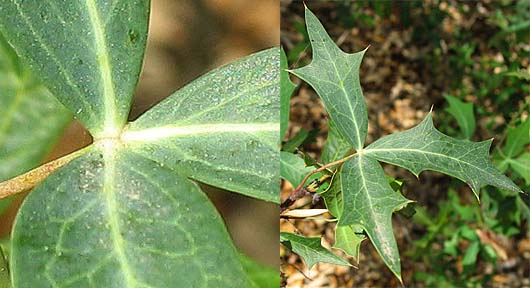
Typical B. trifoliolata shade leaf.
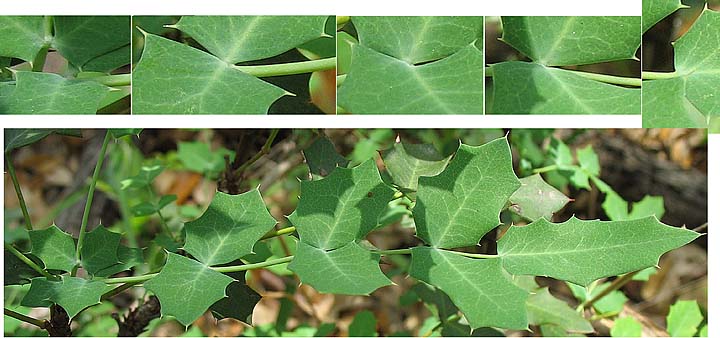
Typical B. swaseyi shade leaf.
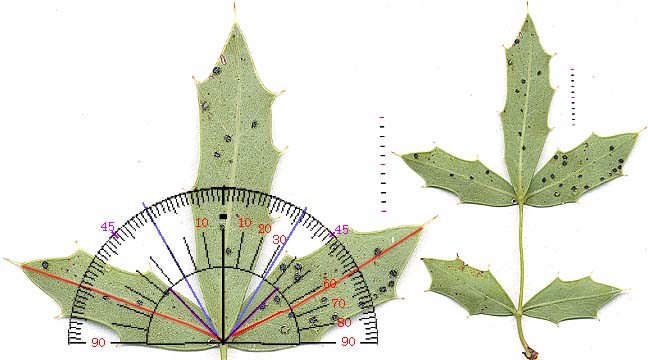
Measuring the terminal base angles (blue lines) of a hybrid.
The approximate angle of the two halves of the leaflet base relative to the leaflet main vein — i.e., both sides of terminals and distal (upper) and proximal (lower) halves of laterals — was determined with a digital protractor. The results are shown in the following table (with 'Lateral I' as topmost). Only the upper two (for hybrids) or three (for B. swaseyi) pairs were measured.
| | Lateral Pair I | Lateral Pair II | Lateral Pair III |
| | Terminal | Distal | Proximal | Distal | Proximal | Distal | Proximal |
| B. trifoliolata |
| Sun | 17° - 40° | 18° - 35° | (14° -) 22° - 38° ( - 46°) | — | — | — | — |
| shade | 30° - 45° | 32° - 46° | 32 - 46 | — | — | — | — |
| Hybrids | 17° - 43° | 30° - 72° | 30° - 82° | 30° - 45° | 35 - 40 | — | — |
| B. swaseyi* | (35° -) 45° - 85° | 40° - 82° | 47° - 100° | 46° - 92° | 60 - 95 | 52° - 75° | 75° - 95° |
* with B. swaseyi, for any given lateral leaflet the angle of the proximal base half was greater than
the angle of the distal base half (or essentially equal to it in 2 instances).
B. trifoliolata
Both terminal and lateral leaflet bases of B. trifoliolata are minimally truncate, commonly at a narrowly acute angle to the main vein, with minor variation resulting from leaflet size. In shade the base may round to c. 46° from the main vein. As the above photo shows, even with these relatively broad leaf bases, there is no leaflet overlap.
B. swaseyi
With B. swaseyi terminals and laterals have quite different base orientation, much great variation for each, although sun & shade differences were minimal (and have been collapsed in the above table). Terminals vary from acute bases with no truncation to bases truncated nearly to right angles (as in the above photo); and together, the angles of the two sides are relatively symmetrical. Lateral leaflet base halves vary from broadly truncate (as in the above photo; to 95°) to acute (40°) to broadly rounded. Most significantly, the distal half of each leaflet invariably presents a more acute angle than the proximal half. In effect, the upper half of a leaflet base tends to parallel the rachis, without crossing to overlap with its leaflet pair on the other side; whereas the overall angle of the leaflet toward the leaf end permits the lower half to be nearly obtuse without encroaching on the opposing leaflet base.
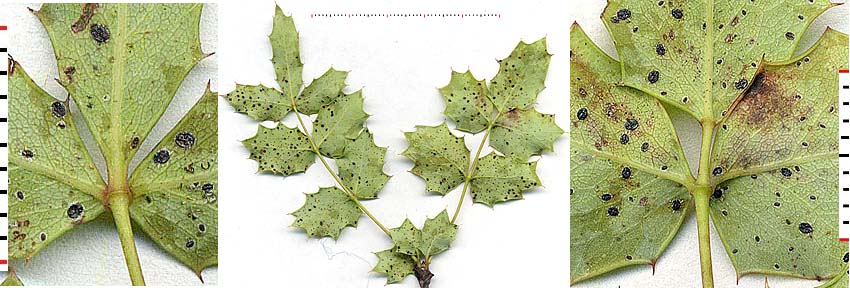
B. Swaseyi: Leaflet variation at adjacent budscales.
The above image of leaves from adjacent budscales would seem to support the view that absence of a separating rachis stalk (on the left) has contributed to the the acute angles of both terminal adjacent lateral leaf bases — in contrast with the broadly truncate leaflets shown on the right, where the short stalk has not completely prevented some leaflet overlap.
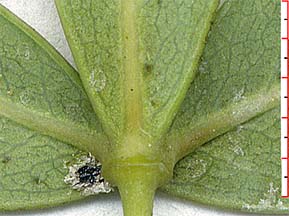 | 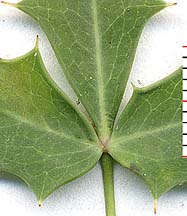 | 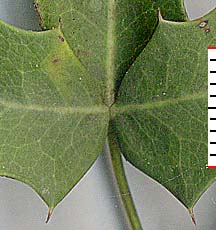 |
| Hybrid H4 |
Hybrid H10 | Hybrid H6 |
Hybrids
Individual hybrid leaflet bases closely parallel those of both species, as illustrated above. Given that hybrid terminals and laterals generally arise from the same rachis node, acute angles for both terminals and laterals would be needed to prevent leaflet overlap, and this would seem to be the case. The base angle data above point up the following similarities with B. trifoliolata:
- Overall more acute base angles.
- No significant base differences between terminal and lateral leaflets.
H4 closely follows the B. trifoliolata base type, with close but non-overlapping leaflets. [The appearance of some slight overlap is an artifact of the leaves having been pressed. The photo at the top of the page clearly illustrates the absence of overlap.] H10 has an acute, nontruncate base similar to the most acute B. swaseyi types. H6 follows the more obtuse B. swaseyi pattern, and in the leaf shown has led to significant leaflet overlap — combining two features which are not both present in the two species: (1) a nonstalked terminal and (2) broadly truncate bases.

